|
APACHE BASKETS

Below are Direct Links to Our Online Catalog
of American Indian items for Sale
American
Indian Art - All Categories
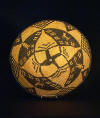

Note: The links above take you from the "article section"
of our website at indianterritory.com to our "dynamic / database driven" Online
Catalog section at navajorugsindianbaskets.com . Artifact thumbnail photos
in the Online Catalog section appear Six items per Page and additional photos
can be found using the arrows at the bottom of each set of thumbnail photos.
Each thumbnail photo is "clickable" with hyperlinks to 1. photo enlargement of
the item 2. description of item including size, age and price in most cases and
3. three close-up or various angle view photos of the same items that will
appear in pop-up windows. Additional information can be obtained using the red
quick inquiry link under the description of
every item in the catalog. (Clicking the
quick inquiry link sends us the ID#
of the item as well as a thumbnail photo. Please include your email address
where prompted or we will be unable to reply.) Also in the top right hand corner
of each artifact's description page you will see these three icons:
The printer icon opens a plain background image of the artifact
suitable for printing for your easy reference. The envelope icon will use your
computer's email program to open an email addressed to us. and the "?" question
mark icon performs the same function as the red
quick inquiry link described above.
About Apache
Baskets - A Brief History
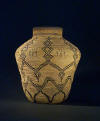 Of
all the baskets of the southwest region , early three rod coiled Apache baskets
of the Western Apache and Yavapai Apache are the most collectible. Of
all the baskets of the southwest region , early three rod coiled Apache baskets
of the Western Apache and Yavapai Apache are the most collectible.
While coarse twined burden baskets are still woven today, Apache
fine coiled willow basketry on the three rod foundation died with the Great
Depression of the 1930's. A number of influences converged at this time.
Tourism to the Southwest slowed. The basket collectors market dropped off as
wealthy collectors bought up existing collections of basketry from "less liquid"
collectors. By the late 19th century the Industrial Revolution had produced
cheap pots and pans so labor intensive basketry was no longer practical or
necessary culturally so most baskets made during the 1880-1930 era were made for
resale. Apache children were sent to government schools and discouraged
from traditional weaving.
An artform perfected over thousands of years was lost in a
decade as weavers took up new lines of work . Generally, only the
relatively quickly made open weave single rod burden baskets continued to be
made for the tourist industry. When the economy and i nterest
in basket collecting returned after World War II, fine three rod coiled basketry
had disappeared; there was no economic incentive to spend months weaving fine
basketry in the new inflationary economy. For these reasons , all the
Apache baskets listed on our website--unless otherwise specified--date from
approx. 1875/1885 (the beginning of the collector period) through 1930 (the end
of fine coiled basketry.) nterest
in basket collecting returned after World War II, fine three rod coiled basketry
had disappeared; there was no economic incentive to spend months weaving fine
basketry in the new inflationary economy. For these reasons , all the
Apache baskets listed on our website--unless otherwise specified--date from
approx. 1875/1885 (the beginning of the collector period) through 1930 (the end
of fine coiled basketry.)
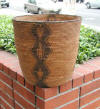
Visually , Apache baskets are striking with strong contrast in
color and bold geometric or pictorial (less common) motifs . Being on a
three rod foundation makes the baskets tight, stiff and sturdy with no bend to
them, and yields rounded well-defined coils that stand out. (By contrast,
Pima baskets of Southern Arizona which use the same external willow and
martynia (devilsclaw seedpod) are coiled on a grass bundle foundation yielding
flatter and less rigid coils. Pimas --which are also relatively more common and
were somewhat more quickly made than the Apaches--often run about one-third the
price of a similar size, form and weave of the more desired Apache. Mint, early
Pima trays might start in the mid hundreds with the best mint Apache trays
starting in the low thousands.
Plant materials used by Apache basket
weavers
Willow shoots -- sized, peeled (whitish originally, aged to a
golden tan /light brown in most all early examples). Rarely, sun-burnt
willow (reddish or golden-red willow) is used in decoration.
Martynia / devilsclaw seed pod --black/dark brown; used in
design
Yucca root -- used sparingly in a small percentage of Apache
baskets; brick red in color.
Forms of Apache Baskets

Most Apache baskets were made as trays (winnowing trays, food
preparing trays) with a slightly concave form. The deeper trays such as this one
are alternatively called either shallow bowls or deep trays.
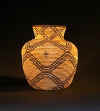
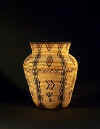
Apache ollas ("olla" prounced "oy-yuh" , a Spanish word meaning
jars with a neck and mouth and in Indian art collecting is used to describe such
forms in both basketry as well as pueblo pottery) come in many forms -- some of
the finest are an idealized human torso form with a base, shoulders, neck and
"mouth".


Two early Apache ollas showing superior form. The polychrome
olla on the left on the red saddleblanket dates to 1880 or earlier and
demonstrates the very small base tapering gracefully to rounded shoulders to a
short but graceful neck and slightly flared at the mouth. The circa 1900 Apache
olla shows a slightly wider base in proportion to the shoulders.
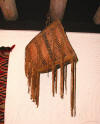
Apache burden baskets like this late 19th century example are
still made by the Apache today. Modern examples usually use commercial leather
and are woven in a larger weave than the pre-1930 examples. The willow on new
examples can be almost white in color while the willow in the older baskets ages
to a golden tan or darker color. Unlike trays, bowls and olla forms Apache
burden baskets are woven in a twining style rather than coiling.
Apache Baskets - Antique vs. Modern
Revivals



1940's Apache Basket "Revival" Basket (above ,left) has large
stitches creating blocky motifs. The photo to the right shows a modern
twined weave on a single rod/stick foundation more quickly woven Apache basket
while the one on the right is a tightly coiled c1900-1920's Apache basketry bowl
woven on a three small willow rods foundation--which creates small even rigid
rounded coils and is a difficult skill requiring long apprenticeship and much
time to create. For many reasons. fine even work as seen in the basket on
the right has for the most part ended with the Great Depression of the 1930's.
Most collectible American Indian baskets that survive today date from the
1880-1930 collector period.
If this page was of interest to you , you may also be
interested in:
Display of Indian Baskets
Care
of Indian Baskets
American Indian Baskets
Below are Direct Links to Our Online Catalog
of American Indian items for Sale
American
Indian Art - All Categories
Articles & Info Coming Soon To Include:
Western Apache
Yavapai Apache
San Carlos Apache
Jicarilla Apache
|

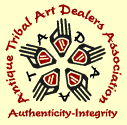



 Of
all the baskets of the southwest region , early three rod coiled Apache baskets
of the Western Apache and Yavapai Apache are the most collectible.
Of
all the baskets of the southwest region , early three rod coiled Apache baskets
of the Western Apache and Yavapai Apache are the most collectible.  nterest
in basket collecting returned after World War II, fine three rod coiled basketry
had disappeared; there was no economic incentive to spend months weaving fine
basketry in the new inflationary economy. For these reasons , all the
Apache baskets listed on our website--unless otherwise specified--date from
approx. 1875/1885 (the beginning of the collector period) through 1930 (the end
of fine coiled basketry.)
nterest
in basket collecting returned after World War II, fine three rod coiled basketry
had disappeared; there was no economic incentive to spend months weaving fine
basketry in the new inflationary economy. For these reasons , all the
Apache baskets listed on our website--unless otherwise specified--date from
approx. 1875/1885 (the beginning of the collector period) through 1930 (the end
of fine coiled basketry.)






